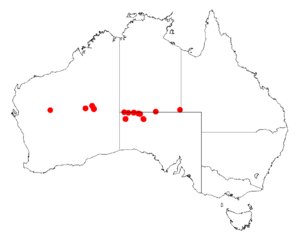Symon's wattle facts for kids
Quick facts for kids Symon's wattle |
|
|---|---|
| Scientific classification | |
| Genus: |
Acacia
|
| Species: |
symonii
|
 |
|
| Occurrence data from AVH | |
Acacia symonii, also known as Symon's wattle, is a special kind of tree or bush. It belongs to a big group of plants called Acacia, which are often called wattles. This plant grows only in certain dry, central parts of Australia. It's a unique part of the Australian landscape!
Contents
What Symon's Wattle Looks Like
Symon's wattle usually grows as a tree or a bush. It can reach a height of 2 to 4 meters (about 6 to 13 feet). Some can even grow as tall as 8 meters (about 26 feet)! It often has a bushy top, like a crown.
Its small branches are usually smooth, meaning they don't have hairs. But sometimes, they might have tiny hairs at their tips. Like most Acacia plants, it doesn't have regular leaves. Instead, it has special leaf-like parts called phyllodes.
These phyllodes are grey-green and stand upright. They are long and thin, either straight or slightly curved. They measure about 8 to 14 centimeters (3 to 5.5 inches) long. They are only about 1.5 to 3 millimeters wide. Each phyllode has three main lines, or nerves, on its surface. The middle nerve is the easiest to see.
Flowers and Seeds
Symon's wattle blooms with yellow flowers from May to September. Its flowers grow in simple clusters called inflorescences. These clusters usually appear alone where the phyllodes join the stem. The flower clusters are shaped like cylinders. They are about 11 to 15 millimeters long and 4 millimeters wide.
After the flowers, brown seed pods start to grow. These pods are long and thin, about 70 millimeters (2.7 inches) long and 3 millimeters wide. The pods can be straight or slightly curved. They are mostly flat but bulge a little where the seeds are. The seeds inside are shiny and light brown. They are about 3 millimeters long and 1.5 millimeters wide.
How Symon's Wattle Got Its Name
The first official description of Symon's wattle was written in 1980. It was described by a botanist named D.J. Whibley. For a short time in 2003, it was called Racosperma symonii. But in 2006, it was moved back to the Acacia group.
The second part of its scientific name, symonii, honors another botanist. His name was D. E. Symon. He was the one who first collected a sample of this plant. This sample is called the type specimen. It helps scientists identify the species.
Where Symon's Wattle Grows
Symon's wattle grows in different places across central Australia. You can find it in northern South Australia and southern parts of the Northern Territory. It also grows in the central Goldfields region of Western Australia. Its growing areas are spread out, not all connected.
This plant often grows on low, rocky hills. It prefers rocky red soils. In Western Australia, it grows north of Wiluna. Its range stretches through the Gibson Desert into South Australia. In South Australia, it is only found in the western parts of the far north region. This includes places like the Everard Ranges and the Birksgate Range, near Mount Lindsay.

